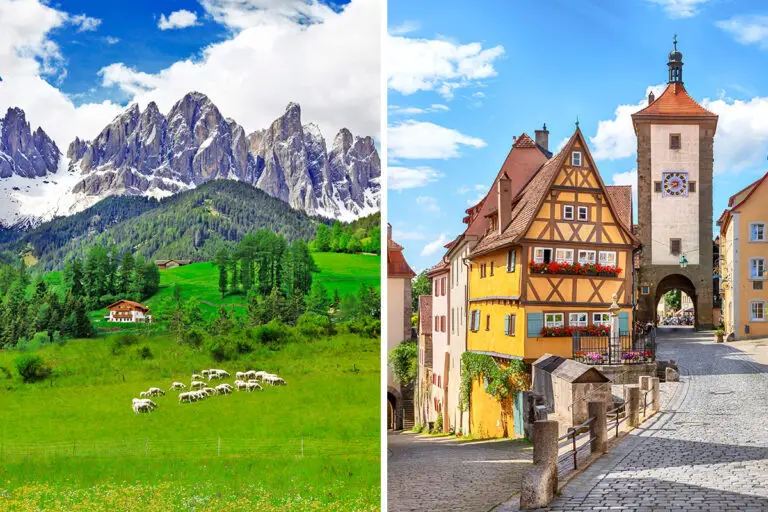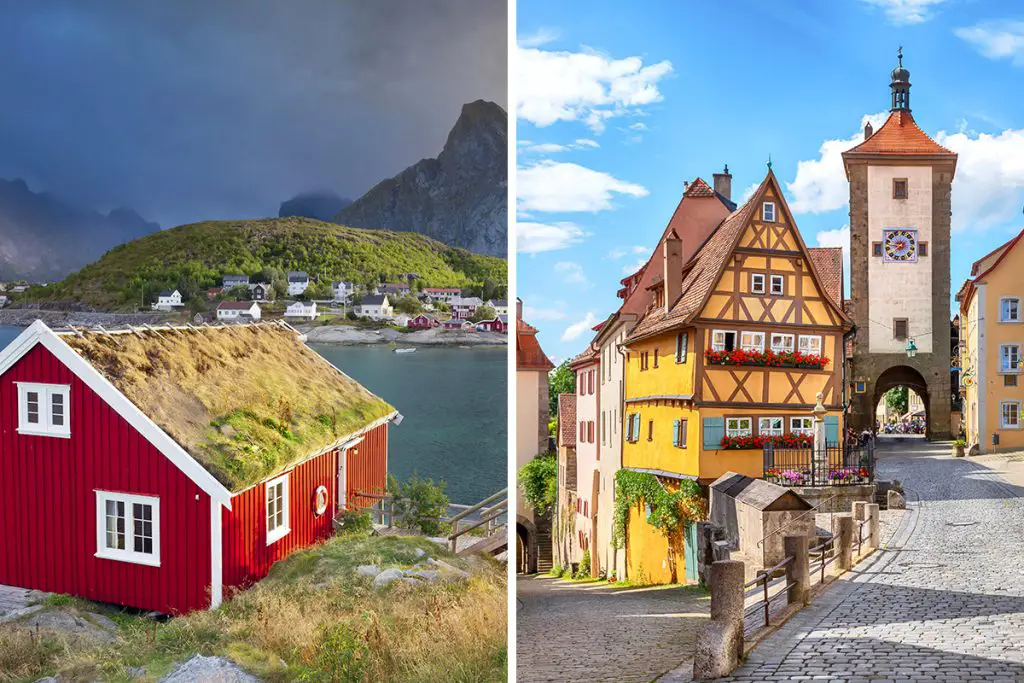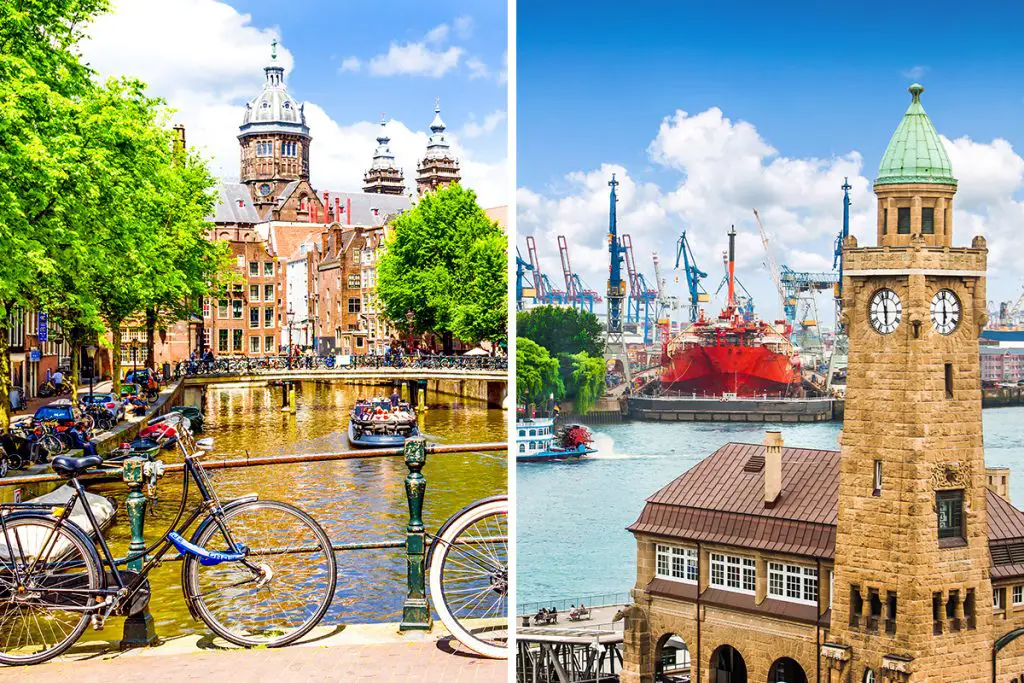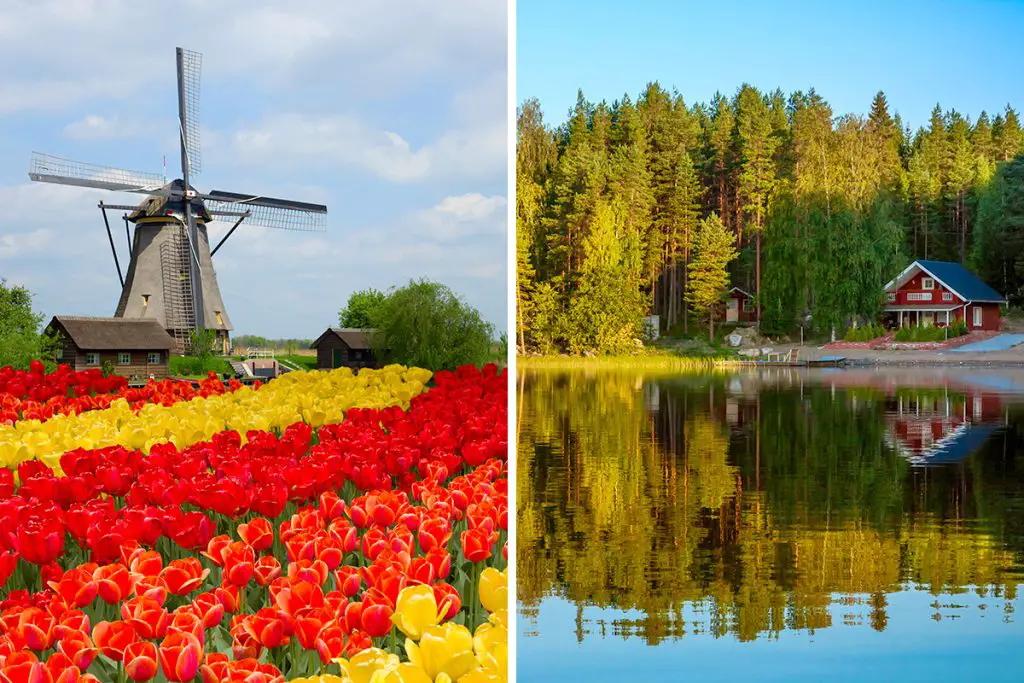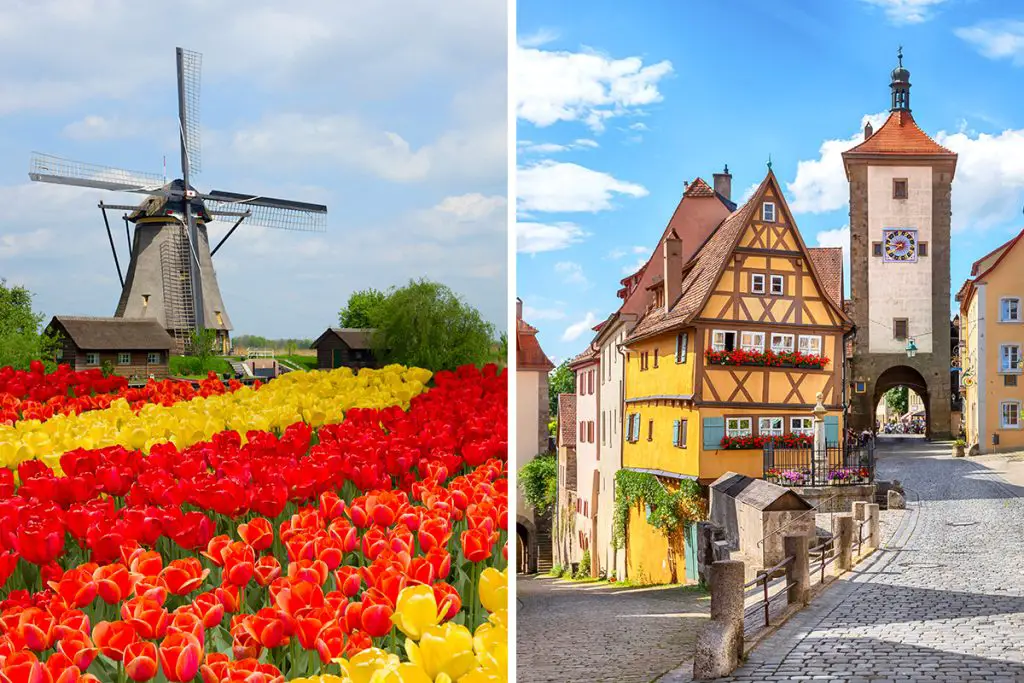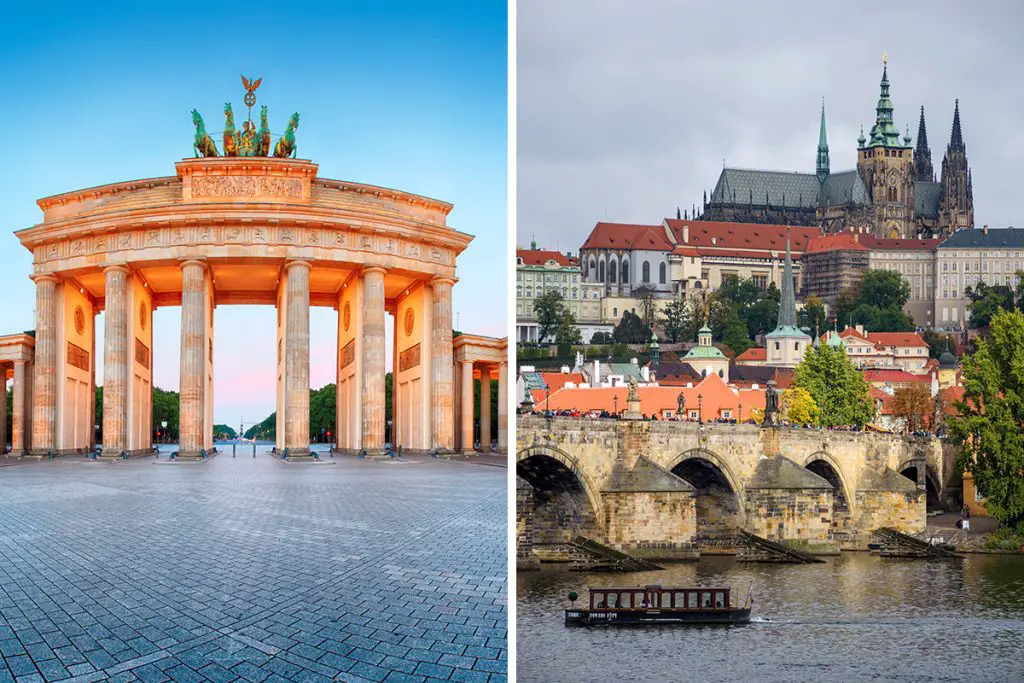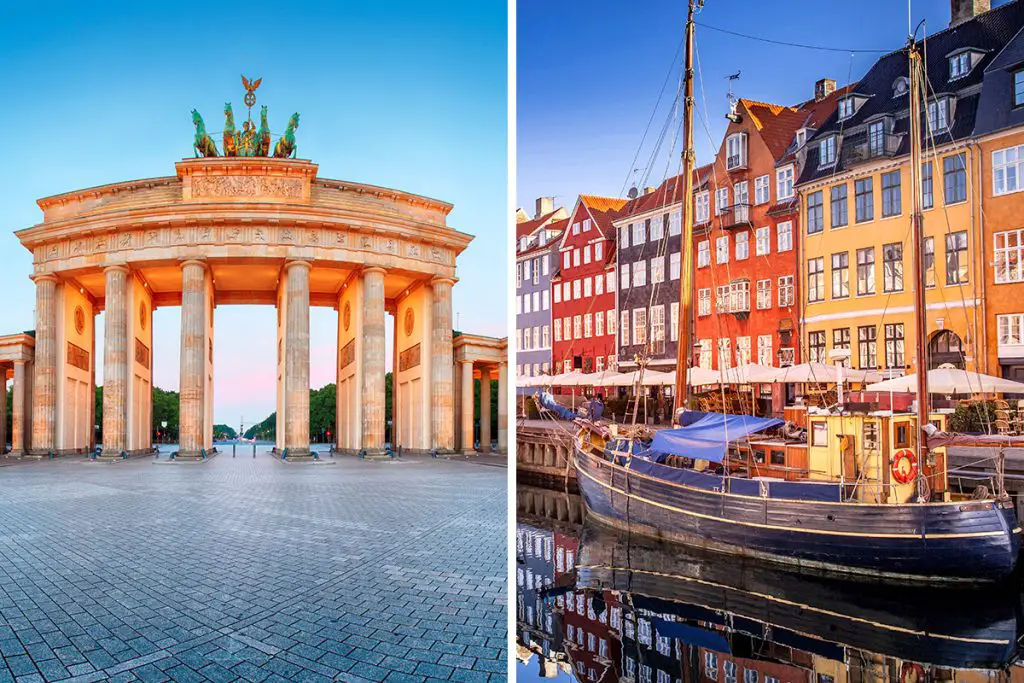Take in the beauty of incredible, centuries-old architecture in big modern cities. Transport yourself back in time to quaint and colorful medieval towns. All while standing in awe of the scenery between them, be it the majestic Alps, the verdant forests, or the strikingly blue lakes.
There’s arguably no place on Earth that does both better than the counties of Austria and Germany. These two have long enchanted tourists for their arresting scenery, be it in the city or the countryside.
Although they may seem similar, Austria and Germany are quite different. And while you can’t go wrong with either, you’ll have to get to know them more below to see which one is perfect for your trip!
Austria
With picturesque landscapes, colorful villages, and stunning architecture, Austria is eye candy. More than a feast for your eyes, a trip here is a treat for your senses. This cultural powerhouse serenades you with its famous music scene, dazzles you with classical art, and much more.
What Makes Austria Unique?
Dive Into Austria’s Vibrant Culture
Austria is a culture buff’s paradise, especially if you love classical music and art. Austria is the country that gifted the world with artistic masters like Klimt and Mozart, among many other big names. And today, their legacy and the country’s love for art live on.
Austria is particularly known for being the heart of European classical music. With an enduring concert culture, you’ll find no shortage of music venues here. And they don’t cost an arm and a leg, as most paid concerts are affordable.
But you don’t even have to enter one to listen to lovely music. The streets of Austria are alive with the music of its legendary composers, especially Salzburg. You may also bump into several free concerts in Austria’s big cities!
The beating heart of the country’s cultural scene, though, is its capital, Vienna. The capital city is home to some of the most exceptional art museums in the world. This includes the Museum of Art History, which features artworks by Rembrandt, Michelangelo, and Raphael.
But other cities in the country are following suit with their robust art scenes too.
Salzburg’s Museum of Modern Art is a must-visit for contemporary art, and so is Graz’ Graz Art Museum. Innsbruck’s Tyrolean Folk Art Museum showcases the exceptional craftsmanship of Austria’s folk art. While Linz’s Ars Electronica Center merges art and technology interactively.
Getting cultured is easy when you’re in a cultural powerhouse like Austria. But it doesn’t stop here. The country has loads of exciting festivals to offer for you to celebrate its rich culture with the locals!
The Viennale film festival is one of the most awaited events in the country. Every October, many vintage cinemas show short films, experimental movies, and more for cinephiles.
At the Danube Island Festival, musicians of various genres from around the world come together. Taking place every June, festival goers have over 600 hours of concerts, along with a plethora of food and drink vans to choose from.
Discover Its Wealth of Awe-Inspiring Architecture
Art isn’t only found indoors in Austria. Going around the country feels like you’re exploring a sprawling and picture-perfect, open-air museum. That’s because everywhere you look, there are tons of architectural masterpieces here.
Austria’s beautiful buildings encompass a wide range of architectural styles.
You’ll find a wealth of landmarks here built during the Red Vienna. This was an era that produced cutting-edge architecture, led by the famous Otto Wagner. But you’ll also find a treasure trove of Baroque, Medieval, and Romanesque styles across the country.
The sheer diversity of architectural styles that Austria homes makes it a worthy destination for aesthetes.
Massive and lavish landmarks, such as castles, are the stars of this scene. But even the most mundane of buildings, like apartments, make you take a second look. When wandering around Austria, you’ll never run out of picture-perfect spots to marvel at.
Walk into history and discover Austria’s rich architectural heritage. There’s no better way to explore this scene than going on a trip to Austria’s historic city centers. There’s one in Vienna, Salzburg, and Graz. And all three are UNESCO World Heritage Sites.
Vienna’s historic center may be small, but it’s filled with worthy attractions. Here, you’ll feel like you’re traveling back in time to the great era of the Habsburg Empire. Some of the famous landmarks here include the Gothic beauty of St. Stephen’s Cathedral and the Baroque palace of Hofburg.
Salzburg’s historic center is among the most beautiful in Europe. Go on a stroll on the pedestrian street of Getreidegasse that’s lined with beautifully-designed shops. Visit the Salzburg Cathedral, Hohensalzburg Fortress, Mirabell Palace, and more!
Graz’s historic center is a delightful blend of German, Mediterranean, and Balkan influences. Running the gamut from Gothic to Baroque to contemporary, Graz’s architectural scene has loads to offer. A highlight here is the Schloss Eggenberg, another Baroque masterpiece.
Marvel at the Beauty of Its Magnificent Landscape
The man-made masterpieces across the country are an unmissable part of Austria’s undeniable beauty. But venture off to the countryside and you’ll find that Austria’s picturesque sights go beyond that.
Austria offers endless expanses of painting-like landscapes.
Think of lush, sunny alpine meadows sprinkled with dense emerald forests. In the backdrop lies towering, snow-capped peaks with clear turquoise lakes at the foothills. Discover granite monoliths, dramatic waterfalls, and plenty more.
In this natural wonderland, you’ll have countless creations by Mother Nature to discover. And when Austria’s enchanting wilderness calls to you, you’re in for a magical and memorable trip.
Austria’s great outdoors is most known for its sky-high alpine summits. If you’re an outdoor enthusiast, you’ll have a blast at the Tyrolean Mountains. This is the best mountain chain in the country.
During summer, it’s a hiker’s paradise. Its famous Eagle Walk route takes you to the most striking sights the Alps have to offer. In winter, it attracts tourists and locals alike for exciting winter sports fun!
As famous as the mountains are the neon-blue waters of Austria’s gorgeous lakes. Go on an adventure to Salzkammergut, a must-visit destination for its glistening lakes!
If you had to visit only one lake in the country, it should be Wörthersee Lake in Carinthia. It’s known to be one of the most beautiful of its kind in the country. Here, you can go swimming, boating, and more, to your heart’s content!
Spending some time going off the grid in the countryside to see these natural wonders isn’t hard to do. Especially if you’re staying in the quaint candy-colored towns nestled in Austria’s great outdoors.
Stay in the charming town of Hallstatt and you’ll have the beautiful Hallstatt Lake in your backyard. Hang out in the village of Alpback and you’ll have a flower-filled wonderland in the summer and a skier’s paradise in the winter.
Get a Taste of Austria’s Irresistible Culinary Scene
Because food is part of cultural identity, diving into Austria’s exciting food scene is one way to get to know the country more. Austrians take pride in their tasty delights. Thus, the dish that’s served on your table isn’t only a reflection of the country’s bountiful surroundings, but it’s also an ode to it.
You won’t find this characteristic only in Austria’s many Michelin-starred restaurants. But you’ll also see and taste it in locally owned shops and centuries-old diners that give you a taste of Austria’s food of the past.
With this, knowing what you want to eat is more important than where you’re eating in Austria. The country has a long, exciting menu of delectable dishes for you to sample. But some of the must-try, tasty delights here are:
- Wiener schnitzel: Austria’s quintessential dish is its most famous one. This is a thinly sliced breaded veal that’s deep-fried in lard or butter until golden brown. It’s then served with fries, potato or cucumber salad, and a wedge of lemon.
- Wiener würstchen: A simple yet tasty Viennese sausage that you’ll find anywhere in the country. It’s a parboiled sausage of pork and beef encased in a sheep’s intestine. It’s served as a main dish with radishes or potato salad or served in a hot bun of various sauces!
- Käsespätzle: This is the Austrian version of the famous comfort food, mac and cheese. It’s a tasty dish of chewy noodles, mixed with thick and creamy Emmentaler cheese and topped with caramelized onions.
- Sachertorte: Known as the world’s most famous cake, a slice of Sachertorte is a sweet way to end any meal. This rich and dense cake is a chocolate lover’s dream. You’ll get two layers of chocolate sponge cake with a layer of apricot jam between them. It’s then coated with dark chocolate ice cream and served with whipped cream on the side.
A Year-Round Exciting Destination
If you’re wondering about the best time to travel to Austria, it’s anytime. This naturally beautiful country has a plethora of things to see and do year-round. And each season has something unique and exciting to offer its visitors.
Winter
Come to Austria from November to March, and you’ll find yourself in a winter wonderland. The highlight of the winter season in the country is Austria’s Christmas markets. With beautiful buildings in the backdrop, choirs singing carols, and stalls buzzing with people, it’s truly magical.
You can go skiing almost anywhere, especially in Kitzbühel, one of the best ski resorts in the country. During March, you can attend the Nostalgia Ski Race. In this event, you’ll find skiers in 20th-century clothing sliding down the Feuerkogel mountain!
Go snowshoeing and winter hiking to explore Alpine valleys and glacier trails. Explore Alpine villages, especially Hallstatt, which becomes even more enchanting in winter. Or pamper yourself in a thermal bath or heated pool, surrounded by powdery snow!
Summer
Summer is the most popular season to visit Austria. With mild weather and long days, the warmer months offer an endless list of outdoor activities!
Other than the majestic Alps, Austria is famous for its stunning lakes. One of the most beautiful lakes in the country is Worthersee. During summer, it’s filled with water activities like canoeing, kayaking, and more! Or, you can swim with the fish at the famous Green Lake.
Snow-free Alpine trails also attract outdoor adventurers of all kinds. Wander through grassy meadows decorated with wildflowers. Conquer rugged peaks, discover roaring waterfalls, cross glacial rivers, and more!
Spring
Austria comes alive during springtime when mother nature goes into full bloom. It’ll be warm enough for you to get all the outdoor adventure you need on your trip too. Go canyoning, hiking, motorbiking, and more!
But this is the best time to take in the beauty of the gorgeous Austrian blooms.
Head to Wachau, a wine-growing region of the country. It’s famous for its 100,000 apricot trees that bloom with flowers each spring!
You’ll even find flowers of all kinds in big cities like Vienna. During spring, the capital’s famous landmarks get framed with magnolia and cherry tree blooms.
Autumn
With crisper air, cooler weather, and fewer tourists, autumn in Austria is a delight. Like summer and spring, autumn offers the perfect conditions for outdoor activities. And it’s especially magical when the great outdoors turns into a magical spectrum of reds, yellows, and oranges.
During autumn, you can experience joyful harvest festivals, like the grape harvests in October. You can help yourself to early wines called Sturm at cozy wine taverns. Or you can be one with the crowd at the contemporary music festival, a much-awaited cultural gathering in Vienna!
Germany
In Germany, tickling everyone’s interests is the name of the game. Thus, it’s a top-tier destination for tourists of all kinds. Enjoy the fast-paced city life or the slow pace of quaint towns, the sandy shores or the dramatic mountains, the beauty of architecture or nature. Whatever you fancy, Germany has it and still has a lot more to offer.
What Makes Germany Unique?
Let Its Natural Beauty Take You on an Adventure
Germany may be famous for its big, vibrant cities and all the allures they have to offer. But there’s so much more to Germany’s scenic beauty outside its urban centers. For the outdoor lover in you, the country’s stunning and diverse landscapes will be your exciting playground.
With dramatic mountains, sprawling valleys, dense forests, rivers, and coasts, Germany has it all. You’ll find these natural wonders across 16 national parks and over 100 nature parks. Plus, Germany boasts 16 UNESCO Biosphere reserves.
Explore Germany’s southern regions and you’ll find the majestic Bavarian Alps. This natural wonder is a source of stunning views and outdoor fun year-round!
During winter, it’s a snow-covered paradise for skiers and other winter sports. During the warmer months, the Alps reveal hiking trails, flower-filled hills, and more.
The Bavarian Alps stretch to Allgäu, a region near Germany’s largest lake, Lake Constance. This lake also borders Austria and Switzerland, but Germany has the greatest share. One of the most beautiful lakes in Europe, you can sail, windsurf, hike, and more here with breathtaking views in the backdrop!
In the north of the country, you’ll find the Baltic and North Seas. Here, you can explore the islands of Amrum and Baltrum. Both feature sweeping dunes, sandy beaches, and quaint fishing villages to explore.
Elsewhere, you’ll find a wealth of rivers flowing through this scenic country. The Rhine River is the most famous one. Fringed with terraced vineyards, charming villages, and medieval castles, a riverboat trip here is a delight.
And while there are countless forests in the country, none are as enchanting as the mystical Black Forest. This has been the setting for a few fairy tales, such as Sleeping Beauty and Rapunzel. With its deep woodlands, half-timbered houses, and cuckoo clocks, it’s easy to see why.
Reconnecting with nature is a magical experience here. The spa towns, incredible bakeries, and other famous landmarks here offer a well-rounded trip to the region too!
Go on a Thrilling Gastronomic Adventure
A trip to Germany also means a thrilling adventure for your taste buds. And if the way to your heart is through your stomach, Germany will do so with diverse cuisine, delicious beer, and inventive concoctions.
Many think that German cuisine is all about sausages. And while Germans do love their sausages, as there are over 1,000 varieties of these, it doesn’t begin to cover what the country has to offer.
Being such a large country, you’ll get to sample an extensive variety of traditional food.
In the north, seafood is king due to its proximity to the sea. Grab a plate of fishbrötchen, a fish sandwich, or a finkenwerder Scholle, which is a pan-fried or baked fish dish. Here, you’ll get the freshest seafood, caught by local fishermen in the morning.
While in the southern areas, you’ll find tasty delights with strong Austrian and Swiss influences. Some must-try dishes are schweinebraten (pork roast) and leberkäse (meatloaf).
While local dishes may vary, what each region has in common is its rich and hearty food. And Germans love to eat well too, so they don’t skimp on portions, leaving you full with each meal.
Germany boasts over 250 Michelin-star restaurants to indulge the foodie in you. But if upscale dining isn’t in the cards for you, don’t worry. You can simply ask around to look for the best restaurants no matter which part of the country you’re in!
From street vendors to beer halls, there are endless options to get a taste of hearty German cuisine.
A Jam-Packed Calendar of Electrifying Festivals
With a busy events calendar of over 10,000 festivals, there’s always something going on in Germany. No matter when you visit the country, there’s always a reason to mingle and celebrate with the fun-loving locals. And the sheer diversity of these festivals ensures that there’s always fun to be had, regardless of your interests.
You can’t talk about German festivals without the world-famous Oktoberfest. This legendary beer festival attracts millions of tourists each year every September! Whether you’re a beer lover or not, the intoxicating and welcoming energy of Oktoberfest will surely be a memorable time for all.
Continuing the all-out fun is the Carnival Season, which begins in November and lasts until Ash Wednesday the next year. Known as the “Fifth Season”, it’s in February when the whole of Germany goes into party mode simultaneously! You’ll find an explosion of colors from intricate floats and costumes, street dancers everywhere, and more!
Being a country that loves music, it’s no wonder Germany has loads of music festivals. There’s the world-famous Wagner Festival in Bayreuth for classical music. And on the other spectrum, there’s the Rock am Ring festival for metal heads, Fusion Festival for techno lovers, and more!
Germany has some unique festivals to offer its visitors too.
If you’re a culture vulture, the Festival Medieval is one that you should attend at least once in your lifetime. Watch some fire shows, explore dungeons, join archery tournaments, and more! It’ll feel like you’re time traveling back in time.
Art Is Everywhere in Germany
Germany has a long, enduring love affair with art that shows its vibrant cultural and historical tapestry. For centuries, the country has made important contributions to art, music, and architecture. And in a country with an insatiable appetite for art, there are a wealth of museums here to indulge your senses.
With over 7,000 museums across the country. Whether your interests lie in art, history, technology, and more, Germany has an answer for you.
The star of Germany’s art scene is Museum Island in Berlin. Composed of eight world-renowned museums, this island is a UNESCO World Heritage Site. With this, Museum Island is a paradise for art lovers.
Elsewhere around the country are many other world-class museums that cover a wide range of topics.
Germanisches Nationalmuseum in Nürnberg is a treasure trove for history buffs. It houses an extensive collection of prehistoric to present-day works. This includes weapons, paintings, and sculptures.
The Mercedes-Benz Museum in Stuttgart dazzles visitors, car lovers or not. The Chocolate Museum in Cologne is a haven for those with a sweet tooth, complete with a chocolate fountain that you can dip a waffle into.
You don’t have to set foot inside a museum to get a dose of Germany’s artistic prowess. Strolling in any part of the country feels like you’re wandering through an open-air museum.
You’ll find a picturesque, fairytale-like wonderland in its many medieval towns. Soak up the delightful atmosphere as you pass by colorful, well-preserved houses in these charming towns:
- Erfurt
- Marburg
- Alsfeld
- Tübignen
An even grander sight is Germany’s wealth of medieval castles. In the Rhine Valley alone, you’ll find over 40 majestic hilltop castles with gorgeous landscapes in the backdrop.
The Neuschwanstein Castle is the most famous one, sitting in the Bavarian Alps. It’s said to be the inspiration for Sleeping Beauty’s Castle. Other, like the Hohenzollern, Schwerin, and Heidelberg castles are just as majestic.
Is Austria Better Than Germany?
Although Austria and Germany offer a well-rounded experience, they each have their strengths. And the better country to visit will depend on what you want out of your trip.
Austria is better for you if you’re a nature lover or if you’re an outdoor enthusiast. Being more mountainous than Germany, the possibilities for some outdoor fun are endless here.
In the Alps and Dolomites alone, you’ll find more than just exciting hiking trails. You can go rock climbing, skiing, kayaking, horseback riding, and more. In Innsbruck, you can go boat riding in mountain lakes, and in Wachau Valley, you can frolic to your heart’s content in the vineyards.
Germany is also great for these, but the flatter landscape means fewer opportunities. If you love beaches though, Germany is the better option as it has amazing coastlines of the Baltic and North Seas.
Germany is better for you if you love the thrill of the big city and all it has to offer. It has several large cities scattered across the country, complete with all the amenities you’d expect. From skyscrapers, trendy fashion, upscale dining, and more, Germany does it better.
Because of this, Germany is also your best bet if you’re a night owl. Austria’s nightlife is pretty laidback compared to what you’d find in Germany.
Berlin is especially legendary for its electrifying nightlife and nonstop parties, while Munich, the birthplace of Oktoberfest, has a thriving and active night scene.
If you’re a history lover, you can’t go wrong with either country. For art enthusiasts, Germany may have the upper hand with its world-renowned Museum Island alone. But if you’re more of a music lover, especially classical music, there’s no better place to be than Austria, particularly in Salzburg.
FAQ
Is Austria Richer Than Germany?
Based on GDP, Germany is a richer country than Austria. Germany has a nominal GDP of around 4 trillion USD, making it one of the richest countries in Europe. Meanwhile, Austria has a nominal GDP of 479 billion USD.
Is Austria Cheaper or More Expensive Than Germany?
Austria and Germany are not the cheapest countries to visit. The cost of traveling in either of the two is quite similar. But generally, Austria is a cheaper destination to travel to.
The average daily cost of visiting Austria is 125 USD per person. Meanwhile, you’ll spend about 129 USD per day in Germany.
A big chunk of this cost goes into accommodation, and in this aspect, Austria is pricier. You’ll spend around 66 USD for a room for one and 132 USD for a room for two in Austria. In Germany, a room for one is around 64 USD and a room for two will be 128 USD.
Getting around each country is another factor to consider, but the prices are similar. The daily cost of traveling within Austria is 21 USD and 20 USD in Germany.
Food is pricier in Germany, and the average daily cost for this is around 34 USD for one person. In Austria, this will be around 32 USD. Alcoholic drinks for a day are around 18 USD in Germany and 15 USD in Austria.
Entertainment costs for a day, like entrance fees, are around 25 USD in Germany and 19 USD in Austria.
Zugspitze in Austria vs. Germany
Standing at 9,718 feet (2,692 m) tall, Zugspitze is the highest point in Germany. But this majestic mountain sits between the border of Germany and Austria. Because of this, you can climb to the top of Zugspitze from either country.
From Germany, you can start your journey at the ski resort of Garmisch-Partenkirchen. Then you can either take a blue Eibsee bus, which will take you directly to Zugsptize in less than an hour. Or you can take the railway station, which passes through Grainau and Eibsee, and climb the mountain on cogwheel power.
Eibsee is a gorgeous lake that sits at the foot of the mountain. An Eibsee-Seilbahn will take you to the peak of Zugspitze in around 10 minutes.
From Austria, you can conquer Zugspitze from Ehrwald, a Tirolean resort. Here, you can ride a Tiroler Zugspitzbahn, which takes you to the peak in 10 minutes.
Most of the infrastructure of the Zugspitze is on the German side. This includes a cafeteria near the terrace. If you want these readily accessible to you, climb the Zugspitze from Germany. But once you’re at the peak, you can access these all even if you’re from the Austrian side.
Salzburg Germany vs. Salzburg Austria
The famous city of Salzburg which became the setting for the movie “The Sound of Music” is in Austria. But in Germany, you’ll find another place named Salzburg too. A small one that sits between Limburg and Siegen.
Salzburg in Germany often flies under the radar of tourists. It’s a very small yet charming village that often gets overshadowed by Germany’s big and vibrant cities. And it’s not well-visited by tourists as it has very few attractions for you to explore.
Meanwhile, Salzburg in Austria is one of the most popular tourist cities in Europe. And there’s more to this lively city than being the film set of The Sound of Music.
Salzburg, Austria is most famous for being the birthplace of Mozart. And here, you can retrace the steps of his time in the city. Plus, you can visit his home at the Mozarts Wohnhaus in Makartplatz.
Moreover, Salzburg in Austria is an enchanting, open-air museum. It’s filled with magnificent historical sites, such as the Old Town, Salzburg Fortress, and Mirabell Palace.
There are also tons of natural wonders to explore here. You can conquer the Austrian Alps, explore ice caves, take a dip in blue lakes, and more!
Are Austria and Germany the Same?
Austria and Germany are not the same. They’re two separate, neighboring countries that are part of Central Europe.
Is Austria a Part of Germany?
Austria is not a part of Germany. These are two separate and distinct countries within Central Europe.
Was Austria Part of Germany?
Austria was once a part of Germany. But these two have had a long history of uniting and getting separated for centuries.
At the start of the 18th century, neither of the two was a country. They were part of a loose collection of territories of the imperial knights called the Holy Roman Empire. And they were considered independent territories.
After the Napoleonic wars, these territories united in the German confederation. And within that, Austria, along with Prussia, were the dominant powers.
Austria and Prussia had a rivalry for the leadership of Germany. But it was Prussia that won this, unifying Germany under their leadership, except Austria. Austria had its own empire as the Austria-Hungary Empire.
Before World War II, Germany annexed Austria, making it a part of Germany. But after the war, the allied powers re-established Austria as an independent nation.
Why Is Austria Not Part of Germany?
Austria was once founded as a part of Germany. Throughout the country’s long history with Germany, many tried to keep Austria independent. It was Adolf Hitler who annexed Austria during World War II, but after Germany’s defeat, Austria again gained its independence.
It was the winners of World War II that made this happen to weaken postwar Germany. And they made it clear with the Austrian State Treaty that a union between Austria and Germany is not allowed in the future.
When Did Austria Separate From Germany?
The Allied Powers of World War II removed Austria from Nazi Germany in late April 1945. Shortly after, a temporary Austrian government was in place. It was Karl Renner who declared Austria’s separation from Germany after the latter’s fall.
Ten years after World War II, in 1955, Austria became the independent Second Republic that exists to this day. And in 1995, the country of Austria became part of the European Union.
Austria to Germany Distance
The distance between Austria and Germany is around 313 miles (503 km). Keep in mind that the actual distance you’ll travel will depend on your start and end point.
Germany and Austria Border
Austria and Germany share a land border that is around 506 miles (815 km) long. The Austria-Germany Border lies in the south of Germany and to the north of Austria, running from east to west.
The easternmost part of the border is a tripoint of Austria, Germany, and the Czech Republic. While the westernmost point is between the two countries and Switzerland. More specifically, the western point of the border lies in the majestic Lake Constance.
From the German side, it’s the famous state of Bavaria that sits near the border. And in Austria, the states of Salzburg, Tyrol, Vorarlberg, and Upper Austria run along this delineation.
Because both countries are part of the European Union, you can travel freely between the two countries with a Schengen visa. But make sure you bring your valid IDs with you, such as your passport.
Is There Border Control Between Germany and Austria?
Because Austria and Germany are part of the European Union, there is usually no border control between the two countries. Both are part of the Schengen area, along with over 20 other European countries. If you have a Schengen visa, you can travel freely between Austria and Germany, and other countries that are part of the area.
Keep in mind that national authorities still carry out border checks between countries from time to time. With this, you should bring your visa and passport with you when crossing borders.
Is Austria Older Than Germany?
Germany is older than Austria. Modern Germany got formed back in 1871. Meanwhile, modern Austria got formed in 1918.
But if you look a bit closer at their long and convoluted history, these two have existed way before then.
The Kingdom of Germany already existed in 843 until the creation of the Holy Roman Empire in 962. This empire collapsed after the fall of Napoleon.
After which, under the Austrian presidency, the German Confederation got formed. The Congress of Vienna unified a loose union of 39 states. Otto von Bismarck then created the German Empire in 1871 after the Franco-Prussian War, which excluded Austria.
Austria was already a distinct political entity back in 976. And you can find the first records of its name back in 996, from a document called Ostarrîchi.
Austria became a duchy in 1156, and an archduchy in 1453. After the Napoleonic Wars, the Empire of Austria Came into existence in 1804. It then became a part of a dual monarchy, the Austro-Hungarian Empire (1867-1918), before the First World War.
After the First World War, the Austro-Hungarian empire collapsed. What became of modern Austria was the unification of the German-speaking provinces of the fallen empire.
Austria vs. Germany Culture
Austria and Germany, being neighbors, have a lot in common. But these two are more different than you’d think. And when you visit both, you’ll see the biggest differences in their everyday life.
The culture in Austria is more relaxed, playful, and personal. This is evident in the way that they talk, and this extends to you as a tourist. Austrians like to address even strangers as “du”, which is often used to refer to family and close relatives.
And to many, Germans are more formal and reserved, be it personal or business affairs. Thus, they often use “sie”, which is a formal way of addressing strangers and acquaintances.
Austria and Germany’s character is also evident in their sense of humor. Austrians love to tell big, elaborate jokes that are often satirical and sarcastic. Meanwhile, Germans have quite a dry humor, and it’s hard to tell if they’re being serious or funny.
In Austria, locals love to engage in long, light conversations. But in Germany, locals are more direct to the point, without beating around the bush.
Austria feels more rural than urban, more ‘country-sided.’ And they’re generally more traditional and conservative. Meanwhile, Germany feels more cosmopolitan and more liberated.
Do Austria and Germany Speak the Same Language?
Austria and Germany speak the same language, which is German. Germany speaks standard German though, while Austria speaks Austrian German. Thus, Austria has its distinct dialect of the language, much like their own version of it.
Still, Austrian German and standard German are pretty similar. Thus, Austrians and Germans can understand each other using these.
Even if you don’t speak the language, you may be able to spot the difference between Austrian German and Germany German. Austrian German sounds as it rises, almost in a melodious way. Meanwhile, in Germany, the language sounds more crips, with much less lilting.
Austria German vs. Germany German
Although they share the same language, Austria’s and Germany’s German are distinct. They may understand each other. But once they speak their own German dialect, communication can be tricky.
The official language in Germany is Hochdeutsch or High German. This is the language taught in schools, you’d read in books, and what you’ll hear on TV.
But the German language is vastly diverse, even within the country. The northern states of Germany use Plattdüütsch, a dialect that’s Dutch-like. The southern states, like Bavaria, have their own dialect too.
Austria’s German language is much like the dialect of Bavaria in Germany. This is likely because Bavaria sits at the international border near Austria. Here, the German dialect is pretty much similar across the country.
But like Germany, some dialects spoken in Austria are distinct. This is especially evident in Vorarlberg. This a mountainous state that borders Germany, Switzerland, and Liechtenstein.
The German spoken here is more like Swiss German. In fact, it’s more like medieval German than High German.
There is such a vast variety of languages within each country. With this, it’ll be hard, if not almost impossible, to pinpoint the main differences in the language in each country.
Austria–Germany Relations
The relationship between Austria and Germany goes beyond their common language. These two countries also share cultures and are especially close due to their centuries-long history. They were under the Holy Roman Empire, fought wars together, and more.
Today, their close ties are still evident as neighboring countries. Austria and Germany have close political, economic, and social relations.
In fact, Germany is Austria’s strongest, most crucial economic partner. And Austria is among Germany’s most crucial trading partners. There are a plethora of companies from each country based in the other.
Beyond that, Germany and Austria also have strong academic and cultural relations. Countless German artists, such as singers, directors, and actors, live and work in Austria and vice versa. These two countries also collaborate on film and TV productions, and they’ve won awards for this too.
Austria is one of the most well-visited vacation destinations for Germans. And because these two are part of the European Union, this makes their already strong links even stronger. Locals can travel to and from either country freely.
As a tourist, you can enjoy the benefits of their good relationship too. With a Schengen visa, you also get to travel to both countries openly.
Germany to Austria Flight
Flying remains to be one of the most popular ways to travel from Germany to Austria. Not only is it the fastest travel option. But there are also tons of flights between the two countries so it’s easy for you to find a flight that fits your schedule.
A flight from Germany to Austria can take anywhere between an hour to three hours. The flight time mostly depends on your inbound and outbound location. But this will also depend on weather conditions and air traffic.
A plane ticket from Germany to Austria comes with a high price tag though. Tickets can range from 140 to 420 USD. But it can be as cheap as 36 USD, especially if you travel in the cheapest month, which is August.
There are over 1,100 flights between the two countries weekly. You’ll have several airlines to choose from that’ll fit your budget too. But the most popular airline for this route is Austrian Airlines.
Several airports in Germany service planes traveling to Austria. This includes Leipzig/Halle Airport, Magdeburg Cochstedt Airport, Paderborn Lippstadt Airport, and more.
Both Austria and Germany follow the same time zone, Central European Time. Thus, getting jet-lagged won’t be an issue.
Austria to Germany Distance by Flight
The shortest airline distance from Austria to Germany is around 313 miles (503 km). But the actual distance you’ll cover largely depends on which city you’re traveling to and from. For example, the flight distance from Vienna in Austria to Frankfurt in Germany is 372 miles (599 km).
Germany to Austria by Train
Because Germany and Austria share a land border, traveling between the two countries by train is easy. You can choose from several train routes that best fit your trip. The popular cities in each country offer direct trains for a smooth and hassle-free journey.
From Munich, you can travel to Salzburg, Vienna, or Innsbruck. Even the cities in northern Germany, such as Berlin and Hamburg, have direct train options to Austria.
From Munich to Vienna, you’ll travel from Munchen Hbf to Wien Hbf in around 4 hours. There are around 8 trains traveling this route each day. The first train leaves Munich at around 11:55 PM, while the last train leaves at 5:30 PM.
From Munich to Salzburg, your trip will start at München Hbf and end in Salzburg Hbf. This trip lasts for an hour and 28 minutes, and there are around 36 trains on this route daily. The first train on this route leaves Munich at around 12:49 AM, while the last leaves at 11:50 PM.
From Berlin to Vienna, you’ll travel for 8 hours and 40 minutes from Berlin Hbf to Wien Hbf. There’s only one train on this route daily, and it leaves at 6:37 AM.
Distance From Austria to Germany by Train
The train distance from Austria to Germany will depend on your destination and which city you’re traveling from.
Some of the nearest cities from each country are Salzburg in Austria and Munich in Germany. If you’re traveling from Salzburg to Munich, you’ll only cover around 80 miles (128 km).
But keep in mind that Germany is a large country. If you’re traveling further up north, expect a long journey.
For example, a train ride from Vienna in Austria to Berlin in Germany will cover a distance of 285 miles (458 km). And if you’re planning to go to Hamburg from Vienna, the total travel distance is around 463 miles (745 km).
Germany to Austria Train Time
The train time from Austria to Germany will depend on which city you’re traveling to and from. This can take as short as 1 hour and 28 minutes if you’re traveling from Salzburg in Vienna to Munich in Germany. Or it can take as long as 8 hours and 40 minutes if you’re traveling from Vienna in Austria to Berlin in Germany.
Germany to Austria by Car
The car ride from Germany to Austria is a pretty straightforward process. These two share a land border. And when you cross that, there is usually no border control to go through.
From Germany, simply take the Bundesautobahn 3 (A3) and make your way south to Austria.
If you have more time to spare, consider spending a few days in Bavaria. This southern German state is near Germany’s border with Austria. And it’s a prime starting point to explore the German and Austrian Alps.
Can You Drive a Rental Car From Germany to Austria?
Driving from Germany to Austria is possible. And this option allows you to explore scenic spots along the way with freedom.
Germany and Austria are members of the European Union. Because of this, they’re part of the Schengen area. So you can cross their borders freely as long as you have a Schengen visa.
You can even rent a car on your exciting journey too, as some car rental companies allow cross-border travel. Keep in mind that car rental companies from Germany will charge a fee for this.
Interrent and Global Rent a Car charge 11 USD per rental if you request this upon booking online. But if you request this personally on your pick-up day, this fee will go up to 21 USD. Currently, these two companies offer the cheapest cross-border fees for their rental cars.
Europcar charges 16 USD, while Hertz charges 26 USD for cross-border fees. Dollar and Thrifty are the most expensive options, as they charge 51 USD for cross-border fees.
Other than this, you will also need an International Driving Permit. You can apply for one at the Automobile Association of America (AAA). You will have to pay 20 USD once you submit your application.

